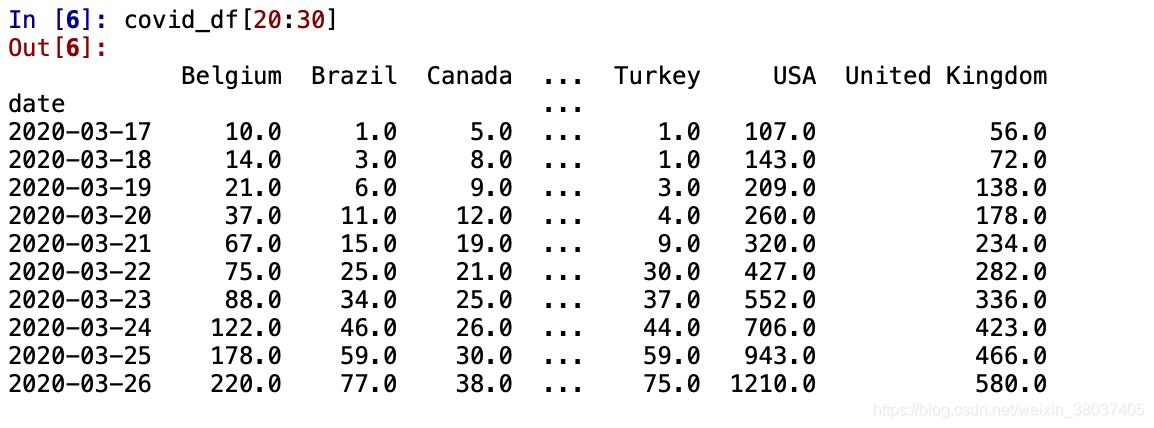目录
数据动画可视化制作在日常工作中是非常实用的一项技能。目前支持动画可视化的库主要以Matplotlib-Animation为主,其特点为:配置复杂,保存动图容易报错。
安装方法
pip install pandas_alive # 或者 conda install pandas_alive -c conda-forge使用说明
pandas_alive 的设计灵感来自 bar_chart_race,为方便快速进行动画可视化制作,在数据的格式上需要满足如下条件:
- 每行表示单个时间段
- 每列包含特定类别的值
- 索引包含时间组件(可选)

支持示例展示
水平条形图
import pandas_alive covid_df = pandas_alive.load_dataset() covid_df.plot_animated(filename='examples/perpendicular-example.gif',perpendicular_bar_func='mean')垂直条形图比赛
import pandas_alive covid_df = pandas_alive.load_dataset() covid_df.plot_animated(filename='examples/example-barv-chart.gif',orientation='v')条形图
与时间与 x 轴一起显示的折线图类似
import pandas_alive covid_df = pandas_alive.load_dataset() covid_df.sum(axis=1).fillna(0).plot_animated(filename='examples/example-bar-chart.gif',kind='bar', period_label={'x':0.1,'y':0.9}, enable_progress_bar=True, steps_per_period=2, interpolate_period=True, period_length=200 )饼图
import pandas_alive covid_df = pandas_alive.load_dataset() covid_df.plot_animated(filename='examples/example-pie-chart.gif',kind="pie",rotatelabels=True,period_label={'x':0,'y':0})多边形地理空间图
import geopandas import pandas_alive import contextily gdf = geopandas.read_file('data/italy-covid-region.gpkg') gdf.index = gdf.region gdf = gdf.drop('region',axis=1) map_chart = gdf.plot_animated(filename='examples/example-geo-polygon-chart.gif',basemap_format={'source':contextily.providers.Stamen.Terrain})多个图表
pandas_alive 支持单个可视化中的多个动画图表。
示例1
import pandas_alive urban_df = pandas_alive.load_dataset("urban_pop") animated_line_chart = ( urban_df.sum(axis=1) .pct_change() .fillna(method='bfill') .mul(100) .plot_animated(kind="line", title="Total % Change in Population",period_label=False,add_legend=False) ) animated_bar_chart = urban_df.plot_animated(n_visible=10,title='Top 10 Populous Countries',period_fmt="%Y") pandas_alive.animate_multiple_plots('examples/example-bar-and-line-urban-chart.gif',[animated_bar_chart,animated_line_chart], title='Urban Population 1977 - 2018', adjust_subplot_top=0.85, enable_progress_bar=True)示例2
import pandas_alive covid_df = pandas_alive.load_dataset() animated_line_chart = covid_df.diff().fillna(0).plot_animated(kind='line',period_label=False,add_legend=False) animated_bar_chart = covid_df.plot_animated(n_visible=10) pandas_alive.animate_multiple_plots('examples/example-bar-and-line-chart.gif',[animated_bar_chart,animated_line_chart], enable_progress_bar=True)示例3
import pandas_alive import pandas as pd data_raw = pd.read_csv( "https://raw.githubusercontent.com/owid/owid-datasets/master/datasets/Long%20run%20life%20expectancy%20-%20Gapminder%2C%20UN/Long%20run%20life%20expectancy%20-%20Gapminder%2C%20UN.csv" ) list_G7 = [ "Canada", "France", "Germany", "Italy", "Japan", "United Kingdom", "United States", ] data_raw = data_raw.pivot( index="Year", columns="Entity", values="Life expectancy (Gapminder, UN)" ) data = pd.DataFrame() data["Year"] = data_raw.reset_index()["Year"] for country in list_G7: data[country] = data_raw[country].values data = data.fillna(method="pad") data = data.fillna(0) data = data.set_index("Year").loc[1900:].reset_index() data["Year"] = pd.to_datetime(data.reset_index()["Year"].astype(str)) data = data.set_index("Year") animated_bar_chart = data.plot_animated( period_fmt="%Y",perpendicular_bar_func="mean", period_length=200,fixed_max=True ) animated_line_chart = data.plot_animated( kind="line", period_fmt="%Y", period_length=200,fixed_max=True ) pandas_alive.animate_multiple_plots( "examples/life-expectancy.gif", plots=[animated_bar_chart, animated_line_chart], title="Life expectancy in G7 countries up to 2015", adjust_subplot_left=0.2, adjust_subplot_top=0.9, enable_progress_bar=True )示例4
import geopandas import pandas as pd import pandas_alive import contextily import matplotlib.pyplot as plt import urllib.request, json with urllib.request.urlopen( "https://data.nsw.gov.au/data/api/3/action/package_show?id=aefcde60-3b0c-4bc0-9af1-6fe652944ec2" ) as url: data = json.loads(url.read().decode()) # Extract url to csv component covid_nsw_data_url = data["result"]["resources"][0]["url"] # Read csv from data API url nsw_covid = pd.read_csv(covid_nsw_data_url) postcode_dataset = pd.read_csv("data/postcode-data.csv") # Prepare data from NSW health dataset nsw_covid = nsw_covid.fillna(9999) nsw_covid["postcode"] = nsw_covid["postcode"].astype(int) grouped_df = nsw_covid.groupby(["notification_date", "postcode"]).size() grouped_df = pd.DataFrame(grouped_df).unstack() grouped_df.columns = grouped_df.columns.droplevel().astype(str) grouped_df = grouped_df.fillna(0) grouped_df.index = pd.to_datetime(grouped_df.index) cases_df = grouped_df # Clean data in postcode dataset prior to matching grouped_df = grouped_df.T postcode_dataset = postcode_dataset[postcode_dataset['Longitude'].notna()] postcode_dataset = postcode_dataset[postcode_dataset['Longitude'] != 0] postcode_dataset = postcode_dataset[postcode_dataset['Latitude'].notna()] postcode_dataset = postcode_dataset[postcode_dataset['Latitude'] != 0] postcode_dataset['Postcode'] = postcode_dataset['Postcode'].astype(str) # Build GeoDataFrame from Lat Long dataset and make map chart grouped_df['Longitude'] = grouped_df.index.map(postcode_dataset.set_index('Postcode')['Longitude'].to_dict()) grouped_df['Latitude'] = grouped_df.index.map(postcode_dataset.set_index('Postcode')['Latitude'].to_dict()) gdf = geopandas.GeoDataFrame( grouped_df, geometry=geopandas.points_from_xy(grouped_df.Longitude, grouped_df.Latitude),crs="EPSG:4326") gdf = gdf.dropna() # Prepare GeoDataFrame for writing to geopackage gdf = gdf.drop(['Longitude','Latitude'],axis=1) gdf.columns = gdf.columns.astype(str) gdf['postcode'] = gdf.index gdf.to_file("data/nsw-covid19-cases-by-postcode.gpkg", layer='nsw-postcode-covid', driver="GPKG") # Prepare GeoDataFrame for plotting gdf.index = gdf.postcode gdf = gdf.drop('postcode',axis=1) gdf = gdf.to_crs("EPSG:3857") #Web Mercator map_chart = gdf.plot_animated(basemap_format={'source':contextily.providers.Stamen.Terrain},cmap='cool') cases_df.to_csv('data/nsw-covid-cases-by-postcode.csv') from datetime import datetime bar_chart = cases_df.sum(axis=1).plot_animated( kind='line', label_events={ 'Ruby Princess Disembark':datetime.strptime("19/03/2020", "%d/%m/%Y"), 'Lockdown':datetime.strptime("31/03/2020", "%d/%m/%Y") }, fill_under_line_color="blue", add_legend=False ) map_chart.ax.set_title('Cases by Location') grouped_df = pd.read_csv('data/nsw-covid-cases-by-postcode.csv', index_col=0, parse_dates=[0]) line_chart = ( grouped_df.sum(axis=1) .cumsum() .fillna(0) .plot_animated(kind="line", period_label=False, title="Cumulative Total Cases", add_legend=False) ) def current_total(values): total = values.sum() s = f'Total : {int(total)}' return {'x': .85, 'y': .2, 's': s, 'ha': 'right', 'size': 11} race_chart = grouped_df.cumsum().plot_animated( n_visible=5, title="Cases by Postcode", period_label=False,period_summary_func=current_total ) import time timestr = time.strftime("%d/%m/%Y") plots = [bar_chart, line_chart, map_chart, race_chart] from matplotlib import rcParams rcParams.update({"figure.autolayout": False}) # make sure figures are `Figure()` instances figs = plt.Figure() gs = figs.add_gridspec(2, 3, hspace=0.5) f3_ax1 = figs.add_subplot(gs[0, :]) f3_ax1.set_title(bar_chart.title) bar_chart.ax = f3_ax1 f3_ax2 = figs.add_subplot(gs[1, 0]) f3_ax2.set_title(line_chart.title) line_chart.ax = f3_ax2 f3_ax3 = figs.add_subplot(gs[1, 1]) f3_ax3.set_title(map_chart.title) map_chart.ax = f3_ax3 f3_ax4 = figs.add_subplot(gs[1, 2]) f3_ax4.set_title(race_chart.title) race_chart.ax = f3_ax4 timestr = cases_df.index.max().strftime("%d/%m/%Y") figs.suptitle(f"NSW COVID-19 Confirmed Cases up to {timestr}") pandas_alive.animate_multiple_plots( 'examples/nsw-covid.gif', plots, figs, enable_progress_bar=True )总结
Pandas_Alive 是一款非常好玩、实用的动画可视化制图工具,以上就是python机器学习使数据更鲜活的可视化工具Pandas_Alive的详细内容,更多关于python机器学习可视化工具Pandas_Alive的资料请关注python博客其它相关文章!
- << 上一篇 下一篇 >>
- 相关文章
- 2021-12-20Python 实现图片色彩转换案例
- 2021-12-20python初学定义函数
- 2021-12-20图文详解Python如何导入自己编写的py文件
- 2021-12-20python二分法查找实例代码
- 2021-12-20Pyinstaller打包工具的使用以及避坑
- 2021-12-20Facebook开源一站式服务python时序利器Kats详解
- 2021-12-20pyCaret效率倍增开源低代码的python机器学习工具
- 2021-12-20python机器学习使数据更鲜活的可视化工具Pandas_Alive
- 2021-12-20python读写文件with open的介绍
- 2021-12-20Python生成任意波形并存为txt的实现
-
搜索
-
-
推荐资源
-
Powered By python教程网 鲁ICP备18013710号
python博客 - 小白学python最友好的网站!